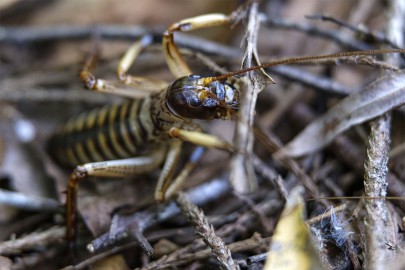
Male wētā amongst decaying plant matter at Elsthorpe Bush in Hawke’s Ba
In response, numerous ecological restoration projects have been set up across New Zealand and its offshore islands. However, we don’t yet know how the story will end. Each project has reported local predator control successes, but their collective contribution to the overall biodiversity narrative has remained unclear.
Manaaki Whenua researchers Rachelle Binny, John Innes, Andrea Byrom (NZ Biological Heritage National Science Challenge), Neil Fitzgerald, Robbie Price, and Roger Pech recently joined forces with researchers at DOC, University of Canterbury, and Te Pūnaha Matatini, to undertake a national meta-analysis of mainland restoration projects and their biodiversity outcomes. Over the past 17 years, Manaaki Whenua has run annual ecosanctuaries workshops to facilitate contact between practitioners and to act as a conduit for science into the national sanctuary network. The relationships established through these meetings laid the foundations for a data-sharing collaboration among 27 ecosanctuaries, including projects led by community trusts, regional councils and DOC, who contributed close to 80 biodiversity datasets surveying hundreds of species for this national analysis.
The research team extracted 447 biodiversity response measures, including bird counts, invertebrate counts, seedling and sapling counts, from datasets and scientific reports on 16 sanctuaries with different management approaches to pest control, ranging from ring-fenced ecosanctuaries and peninsular ecosanctuaries to unfenced pest suppression schemes and possum control programmes.
For each response measure an ‘effect size’ was calculated to measure the biodiversity benefit of pest control and these sizes were then combined to give an overall measure of biodiversity benefit across multiple projects. Changes in benefits for birds, invertebrates and vegetation were tracked for each year that there had been intensive multi-species pest control, over 20 years of restoration.
The results, published recently in Ecological Monographs, found that there were strong benefits for native birds, invertebrates, and vegetation from all types of pest-managed restoration on the mainland. The greatest benefits came from pest control regimes that focused on eradication, such as fenced ecosanctuaries.
Within bird species, deep endemics benefited the most from pest control, with complete eradication or sustained suppression of pests to very low levels providing the best outcomes. A key finding was that after about 7 years of being pest-free, deep endemics were abundant enough to out-compete exotic bird species. There was also evidence of pest control providing some benefit to endemic invertebrates as well as birds, in particular wētā.
“Thanks to this data-sharing collaboration among ecosanctuaries, we now have extensive new evidence that invasive pest control is an effective approach to ecological restoration,” says Dr Binny. “Knowing the long-term biodiversity benefits we get from eradication compared with suppression will be critical for designing an effective national strategy for restoration on Aotearoa’s mainland.”
Key contact

